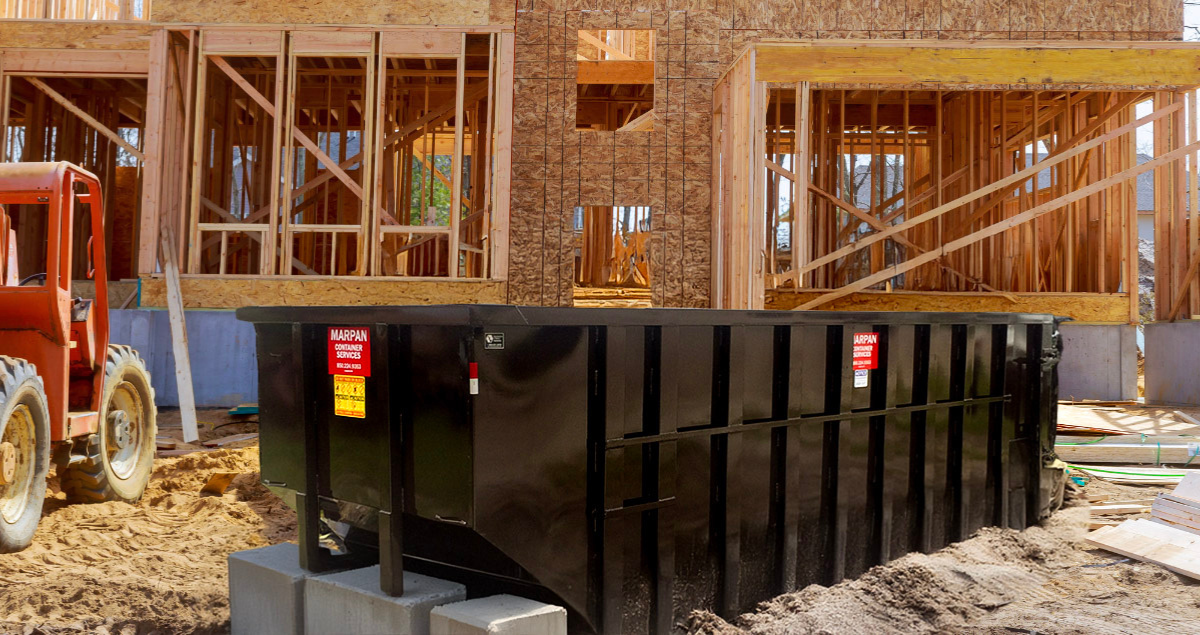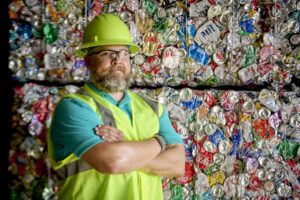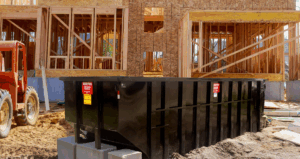From scrap lumber and broken pallets to concrete and packaging, waste builds up quickly on construction sites. Without a plan, it drives up costs, creates safety hazards and can even put you out of compliance with local regulations.
The good news? With the right approach, managing construction and demolition (C&D) debris doesn’t have to be complicated. Here are some proven strategies to keep your jobsite efficient, safe and environmentally responsible.
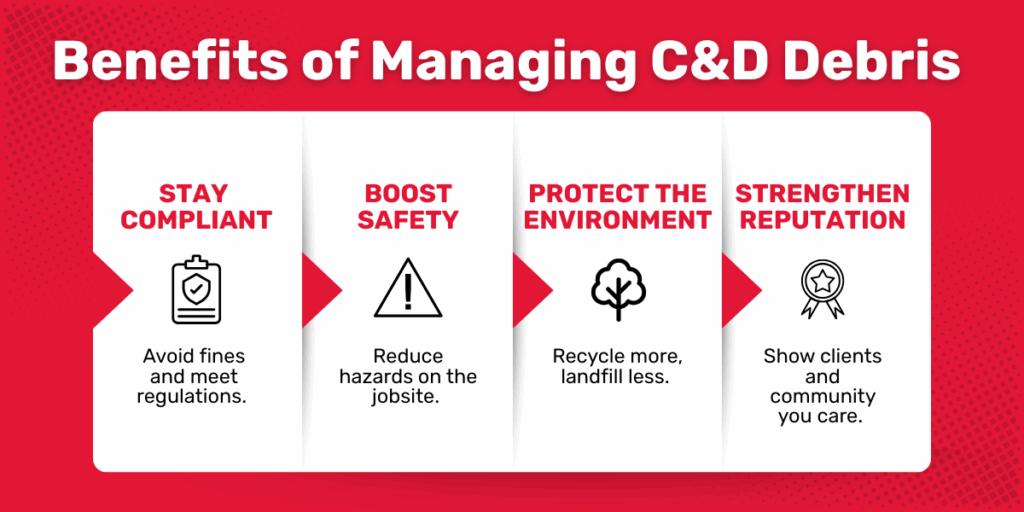
Why Waste Management Matters on the Jobsite
Effective construction site waste management benefits your team and your company’s reputation.
- Stay safe: A cleaner site minimizes trip hazards and keeps work zones clear.
- Stay compliant: Many municipalities require C&D recycling or enforce strict disposal rules.
- Protect your reputation: A well-managed, organized site reflects positively on your company and attracts future clients.
Six Key Strategies for Managing Construction Waste
Effective site management keeps waste under control to maintain a safe, efficient and organized worksite. This guide reviews strategies for managing C&D waste, including proper dumpster selection. Common practices include:
1. Plan Ahead for Waste
- Before breaking ground, think through the waste your project will generate.
- Order materials in the right quantities to avoid excess.
- Schedule deliveries in phases to prevent damage from long-term storage.
- Whenever possible, work with suppliers who reduce packaging or accept returns.
2. Separate Materials for Recycling
- Concrete, asphalt, metals and cardboard can be recycled or repurposed.
- Set up clearly labeled bins or dumpsters for common materials, or work with a recycling partner who sorts debris off-site.
3. Reuse and Salvage Materials
- Don’t let valuable materials go to waste. Reuse scrap lumber, brick and metal where you can.
- Salvage doors, windows, and fixtures for donation or resale. Every bit you repurpose cuts down on disposal volume and replacement costs.
4. Implement Waste-Saving Strategies
- Use modular or prefabricated components to cut down on scrap.
- Train crews on how to cut and use materials efficiently.
- Apply “just-in-time” delivery to avoid damaged or weather-exposed materials.
5. Use the Right Dumpster Strategy
- Place dumpsters where crews can easily access them, size them correctly for each phase of the job and schedule regular pick-ups to prevent overflow.
- Partnering with a dumpster provider that offers C&D recycling services makes the process even smoother.
6. Assign Responsibility
- When waste management is everyone’s job, it often becomes no one’s job. Assign a supervisor or waste coordinator to oversee recycling and disposal.
- Provide basic training for your crew so they know what goes where.
- Tracking your waste diversion can also uncover ways to improve efficiency.
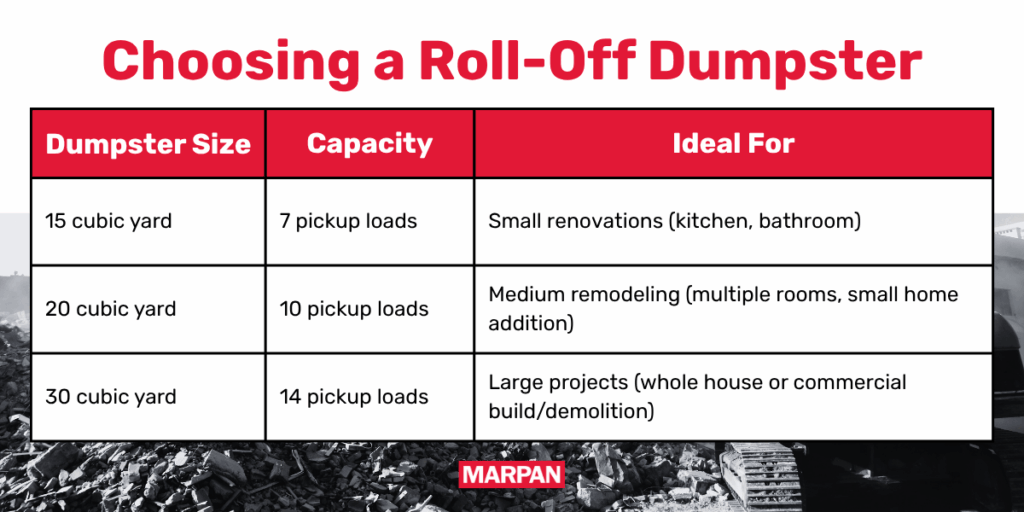
Using a Dumpster for Construction Site Waste Management
Dumpsters are the backbone of site waste management, but only if you use them effectively. Here’s a practical, step-by-step way contractors and site managers can choose the right dumpster size and number for a construction or demolition job:
1. Estimate the Volume of Waste
Roughly calculate cubic yards needed:
- Small renovations (kitchen, bathroom): 15 cubic yards
- Medium remodeling (multiple rooms, small home addition): 20 cubic yards
- Large projects (whole house or commercial build/demolition): 30 cubic yards
Many dumpster rental companies provide a volume estimator chart to use as a starting point.
2. Consider Material Weight
- Heavier materials such as concrete, asphalt, brick and tile may hit weight limits before filling the dumpster volume.
- For mixed-material demolition jobs, it’s often more cost-effective to rent two smaller dumpsters (one for heavy debris like concrete, one for light debris like wood) than one oversized dumpster that hits weight limits early.
- Check the weight limits of your dumpster rental and plan accordingly.
3. Evaluate Project Timeline and Space
- Multiple dumpsters may be needed if the job is large, spread out or staged in phases.
- Consider access for trucks. Dumpsters should be close to work areas but not obstruct traffic or safety zones.
- If the project spans weeks or months, schedule multiple pickups instead of overfilling one dumpster.
4. Factor in Recycling and Separation
If you’re separating materials for recycling:
- Assign dedicated dumpsters for wood, metals, concrete and general trash.
- This reduces contamination and maximizes diversion rates.
5. Confirm With Your Rental Company
- Ask for recommendations based on material type, project size and duration of the job.
- Many rental companies can suggest a combo of dumpster sizes to optimize cost and efficiency.
6. Double-Check Local Rules
Some cities/counties have restrictions on:
- Dumpster placement
- Maximum weight per dumpster
- Permits for street placement
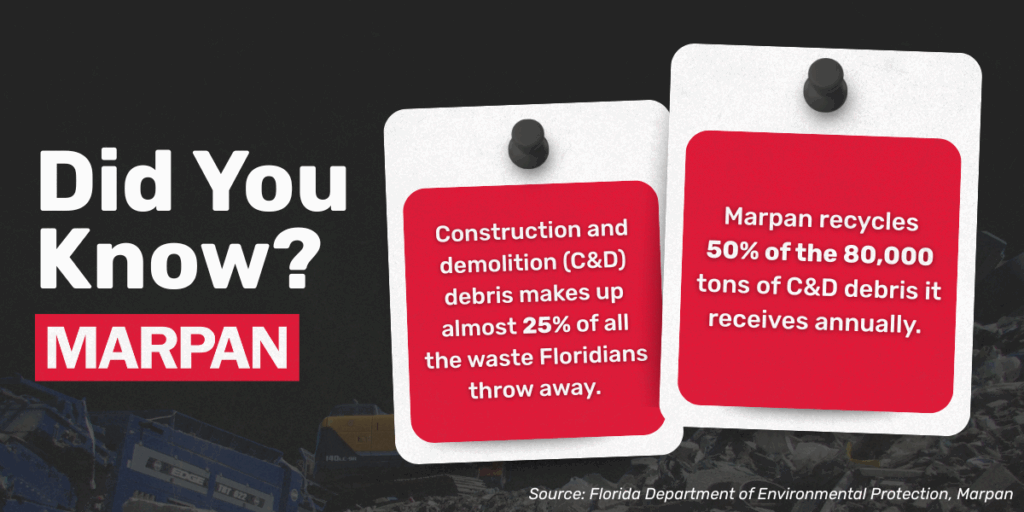
How C&D Recycling Works
Construction and demolition (C&D) debris makes up a significant portion of landfill waste, but a large percentage of it can be recycled or repurposed. Instead of sending everything to the dump, many site managers work with specialized recycling companies to handle this material responsibly. Here’s how C&D recycling works:
- On-Site Segregation: Waste is sorted into separate containers—wood, concrete, asphalt, metals, drywall and cardboard—making it easier for recyclers to process.
- Off-Site Sorting: Some recycling companies provide mixed-waste dumpsters, then sort the materials themselves at their facility. This is useful for smaller sites without room for multiple bins.
Commonly Recycled Materials
- Concrete and Asphalt: Crushed into aggregate for new roads and foundations.
- Wood: Ground into mulch, compost or biomass fuel.
- Metal (steel, copper, aluminum): Melted down and reformed for new construction products.
- Drywall: Processed into soil amendments or used in new wallboard.
- Cardboard and Plastics: Recycled into packaging and new plastic materials.
Partnering with Recycling Experts
Marpan specializes in processing C&D materials at their state-of-the-art facility in Tallahassee, Florida. From concrete and asphalt to metals, wood and cardboard, partnering with a local recycling provider ensures compliance, sustainability and cost savings.
Managing C&D waste protects your budget, keeps your crew safe and demonstrates that you run a professional operation. The simplest way to start? Rent a dumpster built for C&D recycling.
Marpan makes the dumpster rental process convenient and straightforward, helping you choose the right size, schedule service that fits your needs and recycle as much material as possible at our state-of-the-art Tallahassee facility.
About Marpan
Marpan has led Tallahassee and North Florida in debris management and processing of residential and commercial recyclable materials since 1966. Between 2008 and 2022, our recycling facility has recovered more than two billion pounds of material that would have otherwise been buried in a landfill. Our partnerships, long-time commitment to recycling and state-of-the-art facilities allow us to make a difference in our community every day. For more information on how and what we recycle, explore our services.

